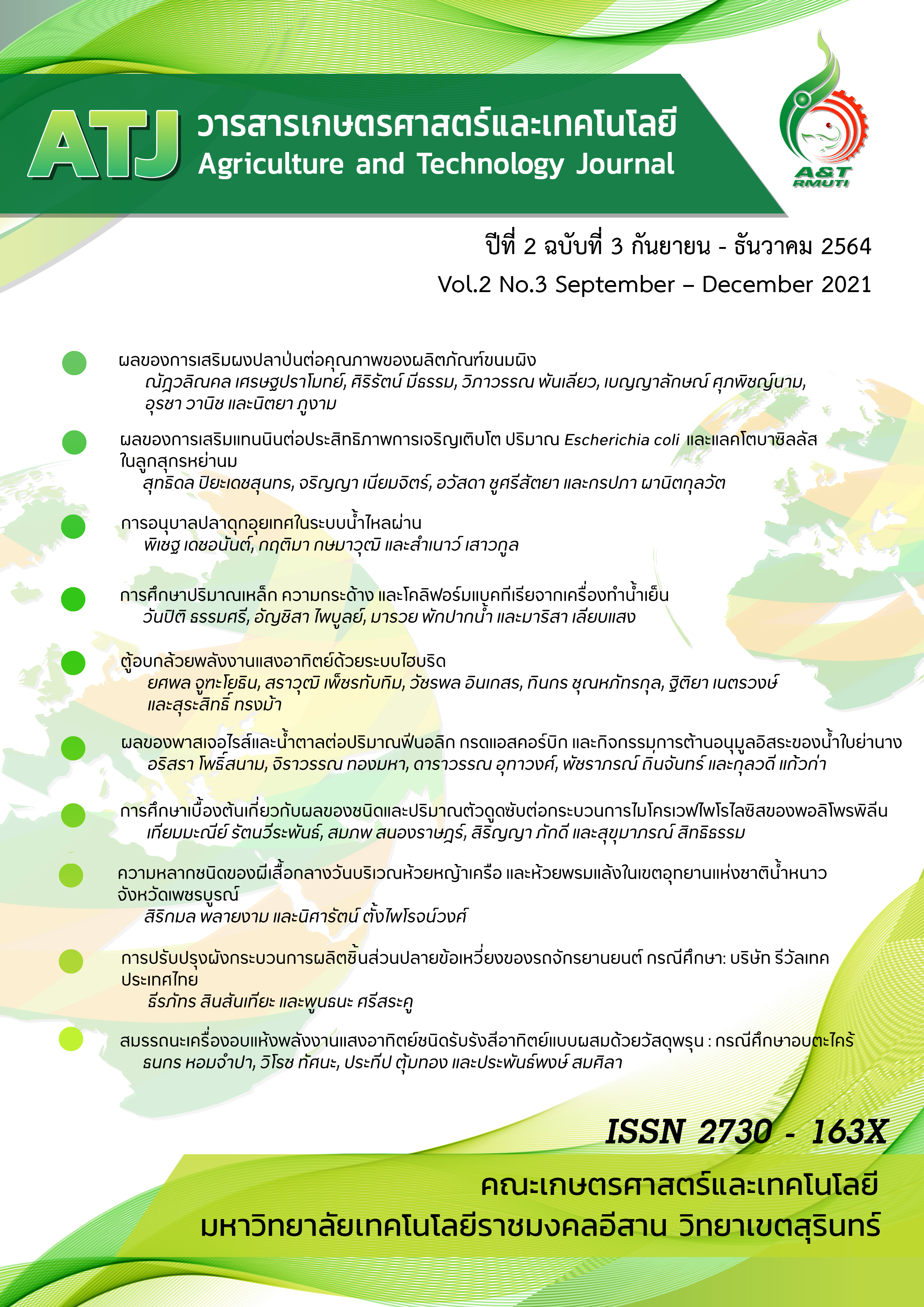ผลของพาสเจอไรส์และน้ำตาลต่อปริมาณฟีนอลิก กรดแอสคอร์บิก และกิจกรรมการต้านอนุมูลอิสระของน้ำใบย่านาง
คำสำคัญ:
น้ำใบย่านาง, พาสเจอไรซ์, กรดแอสคอร์บิก, ฟีนอลิก, กิจกรรมการต้านอนุมูลอิสระบทคัดย่อ
ย่านางเป็นผักพื้นบ้านที่มีคุณค่าทางโภชนาการหลากหลาย ปัจจุบันมีการนำใบย่านางมาแปรรูปเป็นเครื่องดื่มเพื่อสุขภาพ ซึ่งการวิจัยนี้มีวัตถุประสงค์เพื่อศึกษาผลของการเติมน้ำตาล การพาสเจอไรส์ และการเติมน้ำตาลร่วมกับการพาสเจอไรส์ต่อสารออกฤทธิ์ทางชีวภาพและกิจกรรมการต้านอนุมูลอิสระโดยเปรียบเทียบกับเครื่องดื่มน้ำใบย่านางคั้นสด การทดลองแบ่งออกเป็น 4 ตัวอย่างการทดลอง(Treatment) ได้แก่ น้ำใบย่านางที่ไม่เติมน้ำตาลและไม่ผ่านความร้อน (YC) น้ำใบย่านางที่เติมน้ำตาลและไม่ผ่านความร้อน (YS) น้ำใบย่ายางที่ไม่เติมน้ำตาลและผ่านความร้อน (YP) และน้ำใบย่านางที่เติมน้ำตาลและผ่านความร้อน (YSP) ผลการทดลองพบว่าการพาสเจอไรส์ส่งผลต่อการเปลี่ยนแปลงด้านเคมีและกายภาพของน้ำใบย่านาง โดยน้ำใบย่านางที่ผ่านการให้ความร้อนมีค่าความสว่าง (L*) และค่าความเป็นกรด-ด่าง (pH) ลดลง เมื่อพิจารณาสารออกฤทธิ์ทางชีวภาพ (ฟีนอลิกทั้งหมด และกรดแอสคอร์บิก) ในน้ำใบย่านางที่ไม่ผ่านการพาสเจอร์ไรส์ทั้งที่ไม่เติมและเติมน้ำตาล (YC และ YS) มีปริมาณเริ่มต้นใกล้เคียงกันและหลังการพาสเจอร์ไรส์น้ำใบย่านางมีปริมาณฟีนอลิกและกรดแอสคอร์บิกลดลง นอกจากนี้น้ำใบย่านางที่ผ่านการพาสเจอร์ไรส์ทั้งที่ไม่เติมและเติมน้ำตาลมีความสามารถในการต้านอนุมูลอิระลดลง โดยมีค่าลดลงจาก 0.47% (YC) และ 0.79% (YS) เป็น 0.33% (YP) และ 0.67% (YSP) ตามลำดับ โดยสรุปการเติมน้ำตาลและการพาสเจอไรส์ ส่งผลต่อปริมาณสารออกฤทธิ์ทางชีวภาพและกิจกรรมการต้านอนุมูลอิสระของน้ำใบย่านาง
References
จิรภัทร โอทอง, จิราภรณ์ ทองตัน และทัศนีย์ ลิ้มสุวรรณ. (2558). การพัฒนาชาสมุนไพรย่านางและสมบัติด้านเคมีกายภาพฤทธิ์การต้านอนุมูลอิสระและสารประกอบฟีนอลิกทั้งหมด. ใน การประชุมทางวิชาการของมหาวิทยาลัยเกษตรศาสตร์ ครั้งที่ 53. สาขาส่งเสริมการเกษตรและคหกรรมศาสตร์.กรุงเทพมหานคร. 1544-1551.
นิตยา บุญทิม. (ม.ป.ป.). ย่านางสุดยอดอาหารและยา. สถาบันวิจัยวิทยาศาสตร์และเทคโนโลยี มหาวิทยาลัยเชียงใหม่. ค้นเมื่อ 3 พฤศจิกายน 2564. https://stri.cmu.ac.th/pages/about_org.php
บุหรัน พันธุ์สวรรค์. (2556). อนุมูลอิสระ สารต้านอนุมูลอิสระ และการวิเคราะห์ฤทธิ์การต้านอนุมูลอิสระ. วารสารวิทยาศาสตร์และเทคโนโลยี. 21: 275-286.
ปานฤทัย พุทธทองศรี, อภิรดี พันธ์สิงห์ และมะลิวัล ผะสมพืช. (2562). การใช้ใบย่านางและขมิ้นชันเพื่อเพิ่มสารต้านอนุมูลอิสระในกระบวนการผลิตหน่อไม้อบแห้ง. วารสารวิทยาศาสตร์และเทคโนโลยี มหาวิทยาลัยอุบลราชธานี. 21(3): 49-55.
สุนัน ปานสาคร และจตุรงค์ ลังกาพินธุ์. (2563). ผลของการแปรรูปและการให้ความร้อนต่อสมบัติการต้านอนุมูลอิสระ และคุณภาพของเครื่องดื่มข้าวมอลต์จากข้าวพันธุ์ไรซ์เบอรี่. วารสารวิทยาศาสตรและเทคโนโลยี. 29: 119-133.
ศรมน สุทิน. (2559). วิตามินกับอนุมูลอิสระ. วารสารวิทยาศาสตร์และเทคโนโลยี หัวเฉียวเฉลิมพระเกียรติ. 2: 80-92.
ศรินทร์ ทองธรรมชาติ, สุชนา วานิช และนงลักษณ์ ศรีแก้ว. (2557). การศึกษาปริมาณฟีนอลิกและฤทธิ์การต้านอนุมูลอสิระจากสารสกัดใบย่านาง. รายงานการวิจัย. สาขาวิชาเคมี คณะวิทยาศาสตร์และเทคโนโลยี มหาวิทยาลัยราชภัฏมหาสารคาม. มหาสารคาม.
Aamir M., Ovissipour M., Sablani S.S. and Rasco B. (2013). Predicting the quality of pasteurized vegetables using kinetic models: a review. International journal of food science. 1-30.
Aguilar-Rosas S., Ballinas-Casarrubias F., Nevarez-Moorillon M. L., Martin-Belloso G. V. and Ortega-Rivas E. O. (2007). Thermal and pulsed electric fields pasteurization of apple juice: Effects on physicochemical properties and flavour compounds. Journal of Food Engineering. 83(1): 41-46.
Akdaş Z.Z. and Bakkalbaşı E. (2017). Influence of different cooking methods on color, bioactive compounds, and antioxidant activity of kale. International Journal of Food Properties. 20(4): 877-887.
Brand-Williams W., Cuvelier M.E. and Berset C. (1995). Use of a free radical method to evaluate antioxidant activity. LWT-Food science and Technology. 28(1): 25-30.
Benattouche Z., Bouhadi D., Hariri A. and Benchohra M. (2020). Effect of thermal pasteurization on phytochemical characteristics and antioxidant capacity of orange juice. Nature and Technology Journal. 50-53.
Gaur S., Shivhare U.S., Sarkar B.C. and Ahmed J. (2007). Thermal chlorophyll degradation kinetics of mint leaves puree. International Journal of Food Properties. 10(4): 853-865.
Hanh N.T., Hoang N.V. and Tao P.T.P. (2016). Change of chlorophyll and vitamin C In green peas (Pisum Sativum) during thermal processing. Vietnam Journal of Agricultural Sciences. 14(7): 1068-1074.
Khiralla G. and Ali H.M. (2020). Bioavailability and antioxidant potentials of fresh and pasteurized kiwi juice before and after in vitro gastrointestinal digestion. Journal of Food Science and Technology. 57(11): 4277-4285.
Korir M.W., Wachira F.N., Wanyoko J.K., Ngure R.M. and Khalid R. (2014). The fortification of tea with sweeteners and milk and its effect on in vitro antioxidant potential of tea product and glutathione levels in an animal model. Food Chemistry. 145: 145-153.
Laslo V., Socaci S., Teusdea A., Timar A., Tofana M. and Ioana-Vicas S. (2018). The effect of pasteurization time on phytochemical composition and antioxidant capacity of two apple cultivars juices. Bulletin UASVM Food Science and Technology. 75(1): 67-77.
Mashiane P., Mashitoa F.M., Slabbert R.M. and Sivakumar D. (2021). Impact of household cooking techniques on colour, antioxidant and sensory properties of African pumpkin and pumpkin leaves. International Journal of Gastronomy and Food Science. 23: 1-7.
Mohammadzadeh M.J., Amuzadeh A. and Moetamedzadegan A. (2020). Effect of different additives on antioxidant capacity of black tea. Journal of Culinary Science and Technology. 18(2): 67-76.
Norhayati H., Izzreen I. and Hooi P.T. (2019). Effects of pasteurization and different concentrations of xanthan gum on honey beverage. Journal of Food Science. 3: 325-332.
Nwozo S.O., Oso B.J. and Oyinloye B.E. (2015). Effect of heat on antioxidant activity of some tropical leafy vegetables. Nigerian Journal of Basic and Applied Sciences. 23(2): 93-101.
Pellegrini N., Chiavaro E., Gardana C., Mazzeo T., Contino D., Gallo M., Riso P., Fogliano V. and Porrini M. (2010). Effect of different cooking methods on color, phytochemical concentration, and antioxidant capacity of raw and frozen brassica vegetables. Journal of Agricultural and food chemistry. 58(7): 4310-4321.
Rabie M.A., Soliman A.Z., Diaconeasa Z.S. and Constantin B. (2015). Effect of Pasteurization and Shelf Life on the Physicochemical Properties of Physalis (Physalis peruviana L.) Juice. Journal of Food Processing and Preservation. 39(6): 1051-1060.
Ryan-Stoneham T. and Tong C.H. (2000). Degradation kinetics of chlorophyll in peas as a function of pH. Journal of Food Science. 65(8): 1296-1302.
Shalaby E.A., Mahmoud G.I. and Shanab S.M. (2016). Suggested mechanism for the effect of sweeteners on radical scavenging activity of phenolic compounds in black and green tea. Frontiers in Life Science. 9(4): 241-251.
Sharma V., Kumar H.V. and Rao L.J.M. (2008). Influence of milk and sugar on antioxidant potential of black tea. Food Research International. 41(2): 124-129.
Singthong J., Oonsivilai R., Oonmetta-Aree J. and Ningsanond S. (2014). Bioactive compounds and encapsulation of Yanang (Tiliacora triandra) leaves. African Journal of Traditional, Complementary and Alternative Medicines. 11(3): 76-84.
Sukporn S., Sirimuangmoon C., Kondo S. and Setha S. (2019). Effect of harvesting season, maturity stage and storage temperature on internal browning and postharvest quality of ‘Phulae’pineapple. Journal of Food Science and Agricultural Technology. 5: 212-219.
Vegara S., Funes L., Mena P., Martí N., Saura D. and Valero M. (2012) Influence of pasteurization treatment and storage in antioxidant activity of pomegranate juice. International Symposium on the Pomegranate. Zaragoza: CIHEAM / Universidad Miguel Hernández. No. 103: 321-323.
Lončarić A., Pichler A., Rašić N., Vukoja I., Leventić A. and Kopjar M. (2018). Influence of phenol and sugar interactions on antioxidant activity of pomegranate juice. Acta Alimentaria. 47(2): 203-209.
Vongsawasdi P., Nopharatana M., Sasaeng K., Tantek P. and Wongphaisitpisan S. (2010). Kinetics of chlorophyll degradation in pandanus juice during pasteurization. Asian Journal of Food and Agro-Industry. 3(1): 44-51.
Weemaes C.A., Ooms V., Van Loey A.M. and Hendrickx M.E. (1999). Kinetics of chlorophyll degradation and color loss in heated broccoli juice. Journal of Agricultural and Food Chemistry. 47(6): 2404-2409.
Downloads
เผยแพร่แล้ว
Versions
- 16-02-2024 (3)
- 31-12-2021 (2)
- 30-12-2021 (1)
How to Cite
ฉบับ
บท
License
Copyright (c) 2021 วารสารเกษตรศาสตร์และเทคโนโลยี

This work is licensed under a Creative Commons Attribution-NonCommercial-NoDerivatives 4.0 International License.
เนื้อหาและข้อมูลในบทความที่ลงตีพิมพ์ในวารสารทดสอบระบบ ThaiJo2 ถือเป็นข้อคิดเห็นและความรับผิดชอบของผู้เขียนบทความโดยตรงซึ่งกองบรรณาธิการวารสาร ไม่จำเป็นต้องเห็นด้วย หรือร่วมรับผิดชอบใดๆ
บทความ ข้อมูล เนื่อหา รูปภาพ ฯลฯ ที่ได้รับการดีพิมพ์ในวารสารทดสอบระบบ ThaiJo2 ถือเป็นลิขสิทธิ์ของวารสารทดสอบระบบ ThaiJo2 หากบุคคลหรือหน่วยงานใดต้องการนำทั้งหมดหรือส่วนหนึ่งส่วนใดไปเผยแพร่หรือเพื่อกระทำการใดๆ จะต้องได้รับอนุญาตเป็นลายลักอักษรณ์จากวารสารทดสอบระบบ ThaiJo2 ก่อนเท่านั้น






